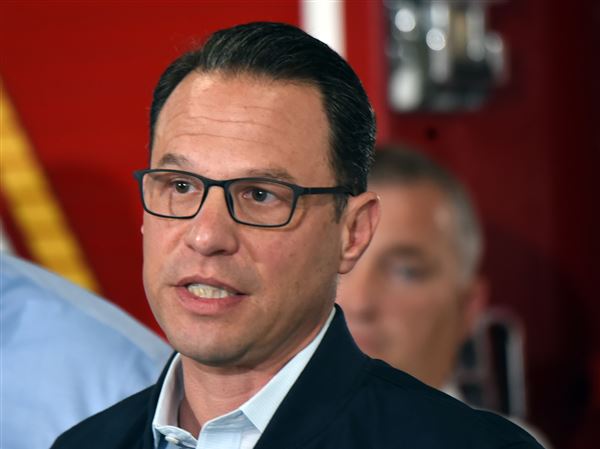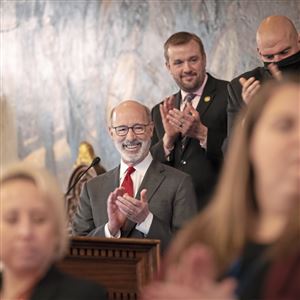Pennsylvania’s 14 state-owned universities, in the midst of controversial campus mergers and a systemwide redesign, would get a historic funding increase in Gov. Tom Wolf’s proposed 2022-23 state budget — a 15% or $75 million boost to $550 million, largest in at least a quarter-century.
The increase across the State System of Higher Education and its nearly 89,000 students is part of a spending plan submitted to the Legislature that also proposes a 5% hike for most public higher education institutions, among them the state-related campuses of the University of Pittsburgh and Penn State, Temple and Lincoln universities.
What will be the governor’s final budget request before leaving office in 2023 also includes $200 million for what he has dubbed the Nellie Bly Tuition Program, which would offer financial assistance for State System and community college students “whose focus involves programs in high-need sectors of the Commonwealth such as health care, education, and public service,” according to the budget document.
In previous years, Mr. Wolf has proposed — without success — a scholarship initiative named for the 19th-century Western Pennsylvania journalist, using repurposed dollars from the Pennsylvania Race Horse Development Trust Fund.
Born in 1867 in Armstrong County as Elizabeth Jane Cochran but better known by her pen name, Bly worked briefly for the Pittsburgh Dispatch in 1885. Forced by finances to leave what now is Indiana University of Pennsylvania after her father died, Bly ultimately left Pennsylvania to pursue a pioneering journalism career that yielded health care system improvements.
In his proposal, Mr. Wolf alluded to Pennsylvania’s near last standing among states in support for higher education — 47th out of 50 states, by one measure. Campus leaders have blamed high tuition and fees in this state in large part on that tepid state support.
“Pennsylvania remains far behind other states in state share of funding for higher education,” says Mr. Wolf’s proposal. “Solutions for efficient and effective operation of higher education institutions should not pass further costs on to students.
“To support PASSHE’s continued organizational transformation and system redesign to operate sustainably and expand student opportunities and outcomes, the 2022-23 budget increases PASSHE’s operating funding by $75 million, further restoring funding to an appropriate operating level,” it added.
Already, influential members of the Republican-led General Assembly are suggesting Mr. Wolf, a Democrat, has put forth a legacy spending increase out of touch with fiscal reality — even in a period when tax revenues are up. They spoke minutes after the governor’s remarks in Harrisburg.
“While this year’s revenues continue to outpace estimates, the long-term financial picture for the Commonwealth remains uncertain,’’ said Senate Appropriations Committee chairman Pat Browne, R-Lehigh. ’’The governor’s revenue and spending projections over the next several years are unrealistic.’’
But among higher education leaders, in particular those across the State System, Tuesday’s dollar proposal represents a turning point that could finally extricate Pennsylvania from its perennial near-bottom status among states in public support for higher education.
State System leaders, including Chancellor Daniel Greenstein, have said a bold increase in state support is critical to efforts to right the system, including the mergers of California, Clarion and Edinboro universities in the west and Bloomsburg, Lock Haven and Mansfield in the Northeast.
“The governor’s proposed budget recommends an historic investment in the State System supporting its reinvigoration as a critical engine of workforce development and social mobility in Pennsylvania,” Mr. Greenstein’s office said in response to Tuesday’s budget proposal.
“This investment will drive continuing transformational change that is underway — change that will ensure all Pennsylvanians have affordable pathways to postsecondary credentials and the opportunities those credentials provide for people to sustain themselves and their families.
“We are grateful,” it added.
The Association of Pennsylvania State College and University Faculties, which has vigorously sparred with system leaders over campus mergers and redesign, expressed similar praise. It noted the plan also includes $150 million in American Rescue Plan funding that will go to faculty and staff support; diversity, equity and inclusion initiatives; and continued marketing for State System students to fight student hunger and combat campus sexual assaults.
Jamie Martin, APSCUF president who teaches at Indiana University of Pennsylvania, pointed to the high share of system graduates who pursue careers within Pennsylvania after graduation.
“They are first responders, nurses, police officers and physicians; they work with our children as teachers and counselors; they find success in business, science and art; they work for nonprofit organizations and in government,” she said. “We are the beneficiaries of their successes, and they deserve our support that is included in this budget.”
Like other regional public universities across parts of the nation, the State System has seen a substantial enrollment loss for reasons including a drop in high school graduation numbers.
But Mr. Greenstein has said a big part of that loss is due to rising tuition and other costs that have priced, even the state’s least expensive university option, out of the market for lower- and middle-income families. Those families were the target audience when the system was created in 1982.
The current $7,716 yearly tuition for in-state students, frozen the past three years, is only a part of the cost that with room, board and other fees includes exceeds $20,000 a year.
In all, Mr. Wolf’s budget calls for a $125 million raise for higher education institutions, most on the order of 5%. Increases include:
• Community Colleges and Capital Fund — $14.9 million
• Penn State University — $12.1 million
• Pennsylvania College of Technology — $1.3 million
• Transfer to Agricultural College Land Scrip Fund — $2.7 million
• University of Pittsburgh (including Rural Education Outreach) — $7.7 million
• Temple University — $7.9 million
• Lincoln University — $758,000
• Thaddeus Stevens College of Technology — $935,000
The budget proposes a $663,000 increase for Institutional Assistance Grants, which provide financial assistance to independent nonprofit postsecondary institutions based on the number of state grant-receiving students.
Included as well is a $1.6 million increase for the University of Pennsylvania’s Center for Infectious Disease through the Department of Agriculture.
Bill Schackner: bschackner@post-gazette.com, 412-263-1977 and on Twitter: @Bschackner.
First Published: February 8, 2022, 4:55 p.m.
Updated: February 8, 2022, 5:32 p.m.





















